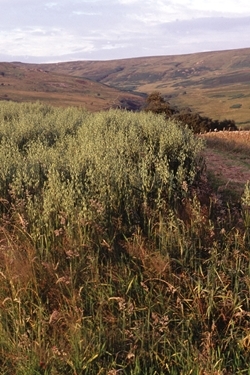Introduction
Black grouse in northern England are found on the moorland fringe. Here they thrive in the transitional white grass moor and rough grazing habitats which adjoin heather moorland managed for red grouse shooting.
Arable in the uplands
Small arable fields were once common in upland Britain, with most farms growing turnips or oats to provide additional winter food for their animals. Historic reports suggest that these crops were frequently used by black grouse during the autumn and winter, particularly oat stooks. In some areas, black grouse were so common that they were often harvested flying from oat fields back to the moor.
Arable crops have since been lost from the majority of the uplands; however, there are now opportunities through agri-environment schemes to re-establish these arable crops. The establishment of arable crops may provide an additional food source for black grouse, but before considering this, it is imperative that other conservation measures have been instigated, primarily predator control and improving moor fringe habitats through sheep-grazing reductions.
 Establishing crops of turnips, oats or specific wild bird mixes for black grouse could be particularly beneficial in areas where productive arable land and reseeded grasslands adjoin moorland habitats frequented by black grouse. These crops may also have wider biodiversity benefits providing feeding and cover for a range of birds including the grey partridge, skylark, twite, linnet, reed bunting, yellowhammer and tree sparrow.
Establishing crops of turnips, oats or specific wild bird mixes for black grouse could be particularly beneficial in areas where productive arable land and reseeded grasslands adjoin moorland habitats frequented by black grouse. These crops may also have wider biodiversity benefits providing feeding and cover for a range of birds including the grey partridge, skylark, twite, linnet, reed bunting, yellowhammer and tree sparrow.
Recommendations
- Before considering establishing arable crops for black grouse, ensure that the essential habitat components of heather moor and rough grazing habitats are present and in good condition.
- The best sites for arable crops are on existing arable land or reseeded and improved pastures. Arable crops should not be established on traditional hay meadows, rough grazing allotments or areas with remaining heather, which may already be of high value to black grouse.
- Seek advice on the siting of new arable crops, within the occupied range of black grouse, from either the GWCT or Natural England.
- To reduce the risk of soil erosion and run-off, careful thought should be given to where arable crops are sited and how they can be managed to reduce such issues.
- Options for establishing arable in the uplands include cereals, root crops such as turnips and kale, as well as plots or strips of wild bird seed mixes.
- Ensure any stubble adjoining heather areas is maintained until the following spring (until at least the 14 February) to provide food for seed-eating birds throughout the winter.
- If possible, tolerate any broadleaved weeds within the crop as this provides an excellent seed source to a wide range of birds when the crop is grazed or harvested.